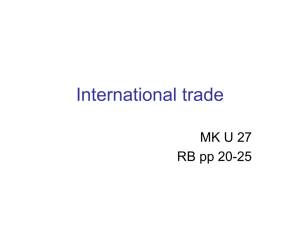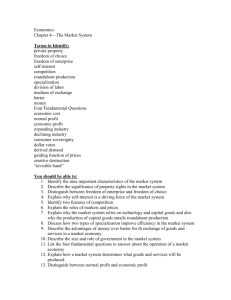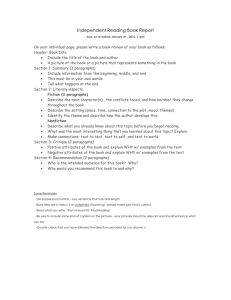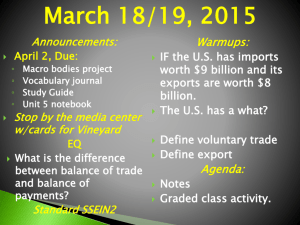Interational trade
advertisement
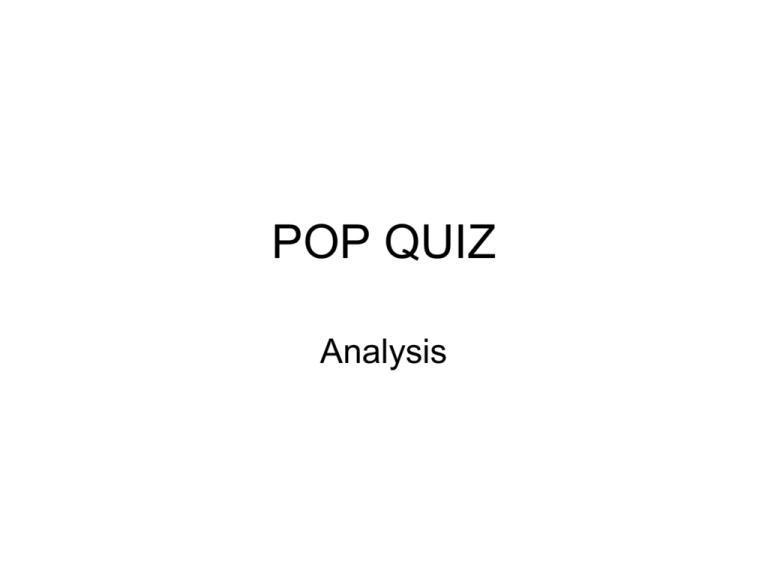
POP QUIZ Analysis Bonus points: • • • • • • • • • • • • Ella Puharić 16/26 = 1 bp Giacomo Trenz 13/26 = ½ bp Kristian Krnić 15/26 = 1 bp Filip Filipović 15/26 = 1 bp Lidija Juzbašić 18/26 = 1 pb Dan Stričević 18/26 = 1 bp Martin Obad 18/26 = 1 bp Karlo Knežević 20,5/26 = 2 bp Lida Matić 17/26 = 1 bp Ivan Knežević 23,5/26 = 2 bp Zvonimir Medvidović 18/26 = 1 bp MacKenzie Moore 17/26 = 1 bp • Fill in the gaps in sentences using grammatically correct forms of verbs rise, raise, slash, arise. arose 1) The financial crisis ___________ in 2008. slash • 2) The Central Bank should ____________ the interest rates to boost the economy. has risen • 3) The value of stocks __________________ significantly since last October. raised their prices. • 4) They had no competitors and they ________ • 5) Trying to recover their research and development costs raised and they ____________ their prices. slashed • 6) In 2007 the Banks ____________ the interest rates to make loans more attractive. • Fill in the gaps in sentences using grammatically correct forms of verbs rise, raise, slash, arise. has risen 7) The market value of Facebook __________________ significantly since the beginning of this year. has arisen 8) Since our last meeting a new problem ____________. slashed 9) In 2003, the FED ____________ the interest rates to boost the economy. rose 10) In October, the value of stocks ________ significantly. Arise (tenses?) The financial crisis ___________ in 2008. Since our last meeting a new problem ____________. Slash (tenses) The Central Bank should ____________ the interest rates to boost the economy. In 2007 the Banks ____________ the interest rates to make loans more attractive. In 2003, the FED ____________ the interest rates to boost the economy. Rise (tenses?) The value of stocks ________________ significantly since last October. The market value of Facebook ___________ significantly since the beginning of this year. In October, the value of stocks ____________ significantly. Raise (tenses?) They had no competitors and they ________ their prices. Trying to recover their research & development costs they ____________ their prices. Graph description: NOUNS (RB, p 31-32) INTERNATIONAL TRADE + * EU* RB, p 45-55 MK, U 27 Trade • DEFINE “TRADE” USING THESE: activity / buying / selling / exchange / goods / services / within / between countries Trade The activity of buying, selling or exchanging goods and services within a country or between countries. (commerce) Source: Longman Business English Dictionary Visible = exchange of goods Trade Visible Invisible Trade = exchange of services Visible Invisible Counter(Barter) Trade = direct exchange, without the use of money From the country Visible Invisible Counter(Barter) Trade To the country Trade Visible Invisible Counter (Barter) From the country To the country Visible Invisible Counter(Barter) Visible Trade Invisible IMPORTS Counter (Barter) Trade EXPORTS From the country Visible To the country BALANCE Visible Trade Trade EXPORTS IMPORTS Balance of trade BALANCE Visible Invisible Counter(Barter) Trade EXPORTS OUTGOING Visible Trade Invisible IMPORTS Counter (Barter) INCOMING Trade in goods + Invisible trade (services) = Balance of payments Visible Invisible Counter(Barter) B E Visible C Trade Invisible N A EXPORTS Counter L A (Barter) Trade IMPORTS Trade deficit Balance of trade Balance of payments Visible Invisible Counter(Barter) B E Visible C Trade Invisible N A IMPORTS Counter L A (Barter) Trade EXPORTS Trade surplus → RB, p 45, task I Balance of trade Balance of payments International trade Teamwork: 1) Brainstorm reasons for importing foreign products: e.g. honey Why import honey? What makes imported honey cheaper? What could make imported honey more expensive? International Trade RB 45-47 Free Trade and Protectionism READING: PROTECTIONISM AND FREE TRADE Plan: 1) Reading groups of paragraphs: 1 + 2 3+4+5 6 +7 8+9 to learn about relevant concepts (e.g. comparative cost principle, tariffs) 2) Focus on vocabulary: typical collocations READING PROTECTIONISM AND FREE TRADE Read paragraphs 1 & 2 to explain: THE COMPARATIVE COST PRINCIPLE ABSOLUTE / COMPARATIVE ADVANTAGE (REASONS & EXAMPLES) Comparative advantage The idea that countries should s________ pecialize in making the products that they are particularly good at making, and mport products that other countries are better should i______ at making. Longman Business English Dictionary • Comparative advantage the advantage that one country has over another because it is better at making a particular product. Longman Business English Dictionary • Absolute advantage is the ability of a country to produce a particular good at a lower absolute cost than any other country. http://www.investopedia.com Absolute or comparative advantage? • Brazil - coffee Absolute advantage (climate) • China - shoes Comparative advantage (low labour costs) • USA - computers • Canada - timber • South Korea - hi-fi Comparative advantage (advanced technology) Absolute advantage (natural resources) Comparative advantage (educated, cheap labour force) Reasons for TRADE LIBERALIZATION (Free trade) • spe_______n • a______e/c________e advantage • a_____s to markets • intern. c________n & efficiency • efficient market m_________m • freer m________t of resources • f______m to choose Reasons for TRADE LIBERALIZATION (free trade) • specialization • absolute/comparative advantage • access to markets • intern. competition & efficiency • efficient market mechanism • freer movement of resources • freedom to choose Collocations from pgs 1 & 2 rai______ living standard spe______ in the production c________ advantage ___ producing... fac______ of production div_______ of labour ec_______ of scale Collocations from pgs 1 & 2 raise living standard specialize in the production comparative advantage in producing... factors of production division of labour economies of scale Free trade vs. Protectionism • International trade (imports and exports) without government estrictions r__________ • Trade of goods and services without trade arriers b_______ • Protection of omestic industries d________ against foreign ompetition c________ • Government restrictions are placed mports of on the i______ foreign competitors (tariffs, quotas and subsidies) Read paragraphs 3, 4 & 5 to explain: PROTECTIONISM AND REASONS FOR PROTECTIONISM TYPES OF TRADE BARRIERS TRADE LIBERALIZATION vs. PROTECTIONISM (reasons for) (reasons for) • specialization • absolute/comparative advantage • access to markets • intern. competition & efficiency • efficient market mechanism • freer movement of resources • freedom to choose • protect jobs (v____s) • protect d_______c ind. • strategic reasons – i_____t industries • • • • • political p______e protect culture (?) r______e prevent d________g reduce a b______e of payment deficit • r_________e against restrictions TRADE LIBERALIZATION vs. PROTECTIONISM (reasons for) (reasons for) • specialization • absolute/comparative advantage • access to markets • intern. competition & efficiency • efficient market mechanism • freer movement of resources • freedom to choose • protect jobs (votes) • protect domestic ind. • strategic reasons – infant industries • • • • • political pressure protect culture (?) revenue prevent dumping reduce a balance of payment deficit • retaliate against restrictions TRADE BARRIERS • Tariffs • Import quotas • Embargo • Subsidies • Non-tariff barriers: Import substitution Safety norms Customs difficulties and delays Name the trade barrier 1. Taxes on imported goods. They raise the price to customers and make them less attractive. Tariffs 2. Limits on the quantity of a product that can be imported Quotas into a country e.g. 200,000 cars. 3. Laws and safety guidelines. Safety norms 4. Making it difficult to arrange all certificates necessary to import into a country. Custom difficulties and delays 5. When a country produces and protects goods that cost more than those made abroad. Import substitution 6. Money paid by a government to producers of certain goods to help them provide low-priced goods without loss to themselves. Subsidy 7. A government order to stop trade with another country. Embargo Barriers to free trade: tariffs, quotas, subsidies, customs duty, import licence, complicated regulations for documents TARIFFS • to impose / set a tariff • to place a tariff on sth • to eliminate / lift a tariff • high / low tariffs QUOTAS • to impose / introduce / lift / set quotas • to increase / raise / reduce a quota • to comply with / exceed quotas Barriers to free trade: tariffs, quotas, subsidies, customs duty, import licence, complicated regulations for documents SUBSIDY • government / state subsidies • to get / qualify for / receive a subsidy • to give / grant / pay / provide a subsidy CUSTOMS DUTY the customs duties on foreign cars Collocations from paragraphs 3, 4 & 5 im________ tariffs & quotas / restrictions pro________ strategic / infant industries ab_________ sectors l____ to structural unemployment red________ a balance of payment deficit pr_________ against dumping des_______ or wea______ competitors ret________ against restrictions a_________ economies of scale s____ a limit to imports pro______ revenue for the government Collocations from paragraphs 3, 4 & 5 impose tariffs & quotas / restrictions protect strategic / infant industries abandon a sector lead to structural unemployment reduce a balance of payment deficit protect against dumping destroy or weaken competitors retaliate against restrictions achieve economies of scale set a limit to imports provide revenue for the government Read paragraphs 6 & 7 to explain: ORGANISATIONS PROMOTING FREE TRADE & THEIR FUNCTION Most favoured nation clause? The final GATT agreement? (when and what?) Which organization superseded GATT? OPPOSITION TO FREE TRADE (who and why?) Removing trade barriers • Organisations set up to encourage the removal of barriers to free global trade: – IMF – World Bank – WTO • Countries join or face exclusion from benefits of free world trade Collocations from paragraphs 6 & 7 gr____ favourable conditions opp_____ free trade countera_____a fall in prices pra______ import substitution Collocations from paragraphs 6 & 7 grant favourable conditions oppose free trade counteract a fall in prices practice import substitution Read paragraphs 8 & 9 to explain: PROBLEMS & FEARS OF DEVELOPING COUNTRIES (IMF) OTHER REASONS FOR DEVELOPING COUNTRIES TO REDUCE THEIR PROTECTIONISM Read paragraphs 8 & 9 to explain: REASONS FOR DEVELOPING COUNTRIES TO REDUCE PROTECTIONISM: 1 need to repay huge d____ - IMF imposed obligation to export 2 s_______ of the East Asian “Tiger” economies 3 c_______ of the Soviet Union 4 potential ex________ from the t______ blocks (the EU, NAFTA) Read paragraphs 8 & 9 to explain: PROBLEMS & FEARS OF DEVELOPING COUNTRIES (IMF) 1 need to repay huge debts - IMF imposed obligation to export 2 success of the East Asian “Tiger” economies 3 collapse of the Soviet Union 4 potential exclusion from the trading blocks (the EU, NAFTA) Collocations from paragraphs 8 & 9: p_____ the interest r______ the principal r______ (renew) a loan r _________ (postpone) repayments i________ severe conditions t_______ blocks l_______the economy l_______trade barriers Collocations from paragraphs 8 & 9: pay the interest repay the principal rollover (renew) a loan reschedule (postpone) repayments impose severe conditions trading blocks liberalize the economy lower trade barriers HW: RB, p 47 Write the questions. RB, pp 48-49 Oh, sweet reason (compare with N on p 135) MK, p 133 Education and protection – read and answer the questions Discussion: For and against free trade → MK, p 134 Vocabulary, pp 132 & 134 Reading and discussing, p 135 Need the following phrases? • • • • • • • • • • • I am sure that... In my opinion... / I believe / From my point of view It is only fair / right to admit... It is difficult to take a firm stand on this, but ... Let me give you an example ... / If I may illustrate ... As / because of / since / consequently / therefore Firstly... Secondly... Thirdly... I am afraid that ... Although .... , I have to say ... Furthermore, ..../ Moreover,.... However,... Report writing task 2, RB p 25 • Teamwork: Write a short report and hand it in.
